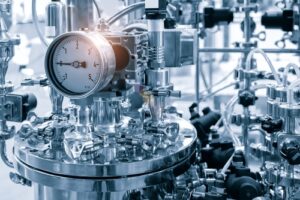The Difference Between Low Pressure and High-Pressure Steam Systems
Last updated on March 13th, 2024 at 03:34 am
Steam pressure systems are the standard heating system for various applications. They’re widely used because of their reliability and durability and because they generate clean, dirt-free heat.
With that said, not all steam pressure systems are built the same. Most of these systems fall into two categories: low-pressure and high-pressure systems. Although both methods effectively generate heat, they both have functional differences. That also makes each type of system more suitable for specific applications compared to others.
This post will examine the technical and functional differences between low-pressure and high-pressure systems and why they matter.
Steam Pressure System PSI Ratings
 The most apparent difference between these two systems is implied by their names – their pressure settings.
The most apparent difference between these two systems is implied by their names – their pressure settings.
Low-pressure steam systems don’t exceed 15 pounds per square inch (psi). By extension, they don’t heat water greater than 250ºF. High-pressure systems, on the other hand, create steam above 15 psi. It’s not uncommon for industrial high-pressure systems to operate at psi levels in the hundreds. That can mean they heat water at temperatures significantly higher than 250ºF.
These differences in pressure (and temperature) influence the applications these systems are used for (more on this below). These differences also have an impact on the overall efficiency of these systems.
Energy Efficiency of Steam Pressure Systems
More companies prioritize energy-efficient processes and are more selective about installing the machinery. That includes heating. A steam pressure system will be more or less efficient depending on which category it falls into.
Generally, a low-pressure steam system requires less energy to create heat since it operates at reduced pressure and temperature. The opposite is true, too – high-pressure systems require more power to produce excellent energy transfer.
However, this doesn’t automatically make low-pressure systems superior to high-pressure ones. Specific industrial applications require high-pressure steam systems since low-pressure ones can’t meet the heating demands of these operations.
Steam Trap Design
A steam trap is to release condensate, non-condensable gases (i.e., hydrogen, nitrogen) and air from a steam pressure system without allowing steam to escape. Of course, the design of a steam trap differs depending on the type of steam pressure system it’s used in.
Low-pressure systems are more likely to contain thermostatic steam traps since they are designed for lower-temperature air. High-pressure systems tend to use disc-type steam traps since they are compact and designed for high temperatures.
Applications of Steam Pressure Systems
The key difference among steam pressure systems is their applications. Due to the energy they generate, each system category will work better for specific applications than others.
Low-pressure steam systems provide heat for water at hospitals, university facilities, offices and condominiums. These buildings require just enough heat to keep occupants comfortable in terms of water and air temperature, making low-pressure systems adequate. With that said, some small-scale industrial facilities can also use low-pressure systems.
Unlike low-pressure systems, high-pressure systems facilitate medium-to-large scale industrial buildings and processes. These operations require ample amounts of energy, which need a greater energy output. The typical industries that use high-pressure steam systems include food processing, manufacturing of consumer goods, and rubber vulcanizing.
Costs of Steam Pressure Systems
 Low-pressure steam systems use less energy to generate heat, making them more economical (at least for low-demand industrial applications). Also, their reduced energy demands mean that they work less, which minimizes the wear and tear on their components. That translates to lower operating and maintenance costs.
Low-pressure steam systems use less energy to generate heat, making them more economical (at least for low-demand industrial applications). Also, their reduced energy demands mean that they work less, which minimizes the wear and tear on their components. That translates to lower operating and maintenance costs.
High-pressure systems do tend to have higher upfront and maintenance costs. However, cost-efficiency is possible even when using a steam pressure system that operates on the higher end.
Benefits of Wattco High-Pressure Systems:
Inline Water Heater
High-pressure systems can benefit from the use of an inline water heater. Essentially, an inline water heater is an immersion heater covered by a metallic vessel chamber that is anti-corrosive. The purpose of this casing is to prevent heat loss. That is crucial because heat loss makes the heating process inefficient and adds to energy costs.
Also, an inline heater transfers heat generated by electrical power into the target fluid so that no energy gets wasted. That makes the increased energy expenditure of high-pressure systems less burdensome and cheaper.
Our inline water heater can accommodate many industrial processes ranging from oil sump heating to corrosive solutions.
How Our Inline Water Heater Improves Your Industrial Processes
- Distributes heat more evenly
- Disperses clean, dirt-free heat
- Reduces vessel heat loss
- Provides maximum dielectric strength
- Generates more power in a smaller heater bundle
Our inline heater is beneficial for applications where high-pressure systems are standard, but energy and operating costs are a concern.
Working Under Pressure
Choosing the right steam pressure system and heater is noticeable for specific applications such as the ones mentioned earlier. However, some industries or processes may allow for some leeway if what heater and steam system are best. In such cases, it’s ideal to choose a system that effectively generates heat for the task at hand above all else.
But looking for energy-efficient options is crucial as well. Wattco offers inline heaters and solutions for steam pressure systems that generate heat efficiently and cost-effectively. The right balance between cost and efficiency will help reduce waste and added expense to your processes.
Are you interested in an energy-efficient and cost-effective solution for your pressure system? Get in touch with us for a consultation and quote.
